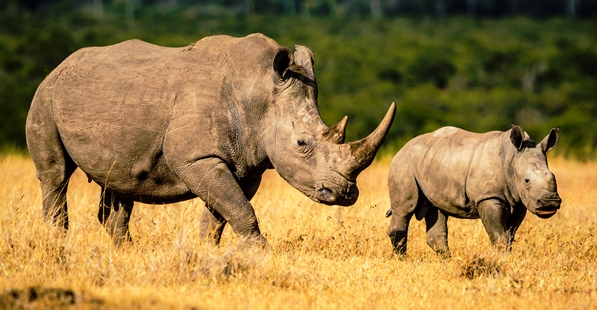The critically endangered northern white rhinoceros (Ceratotherium simum cottoni) is a subspecies of white rhino that is on the brink of complete extinction, with only two individuals left in captivity and no known members reported in the wild. The two remaining individuals are a mother (named Najin) and her daughter (named Fatu) residing at the Ol Pejeta Conservancy in Kenya. As both females are unable to reproduce naturally, scientists have taken the extraordinary step of producing viable embryos in the laboratory. In order to generate the embryos, biologists extracted eggs from the female rhinos; then, the eggs were artificially inseminated with cryopreserved (frozen) sperm from two male northern white rhinos that had died in 2014 and 2006, but whose sperm had been kept in storage and subsequently thawed. Out of 10 eggs that were harvested, 7 successfully matured to the point that they were able to undergo fertilization. However, only 2 of these fertilized eggs (both derived from the daughter Fatu) developed into viable embryos. Until a satisfactory surrogate female individual (most likely a member of the southern white rhino subspecies, which has an estimated population of 20,000) is found, and into whose body either or both of the embryos can be transferred, the 2 embryos have been frozen in order to preserve them for future use. See also: Africa; Cryobiology; Endangered species; Extinction; Fertilization (animal); Genetics; Northern white rhinoceros on the brink of extinction; Population ecology; Population viability; Rhinoceros

The reproductive methodology involved in the conception of the rhino embryos is intracytoplasm sperm injection (ICSI). In this in vitro procedure, a single sperm is selected and inserted directly into the cytoplasm of the oocyte (egg), bypassing stages of fertilization that would otherwise need to occur when the male gamete (sex cell) penetrates the female gamete. In particular, ICSI has been used successfully for clinical applications in the horse-breeding industry. This procedure also has been successful, although to a lesser extent, in pigs. However, ICSI has fallen short with regard to its use in the majority of farm animals and wildlife. See also: Assisted reproductive technology; Ovum; Reproductive technology; Sperm cell
Conservationists hope that a surrogate southern white rhino will be found to carry the embryos to term and ultimately give birth to at least one healthy northern white rhino. This would be a remarkable feat, but it would still be an isolated event and would have no bearing on the ultimate survival of the northern white rhino. To perpetuate the northern subspecies, many rounds of ICSI would be needed. In addition, the offspring derived from any ICSI experiments would not necessarily be healthy and genetically viable. However, the success achieved here puts scientists one step closer to passing on the northern white rhino genome through assisted reproductive techniques. See also: Conservation of species; Pregnancy





